A Joint Decision-Making Approach for Tomato Picking and Distribution Considering Postharvest Maturity
Abstract
1. Introduction
- Maturity characterization. A precise maturity characterization would consider the maturity stages, characteristic indices and temporal distribution.
- Time collaboration. It is a time collaboration problem that decides the expected maturity time window, picking time and distribution time simultaneously.
- Joint decision-making. Picking and distribution processes are interactive for making the picking strategy, vehicle arrangement and optimal routing.
2. Literature Review
3. Model Development
3.1. Problem Description
3.2. Postharvest Maturity Model
3.3. Objective Function
3.4. Constraints
3.5. Model Formulation
4. Implementation of Improved Genetic Algorithm
4.1. Selection Operation
4.2. Self-Adaptive Genetic Operator Probability
4.3. Implementation of IGA
5. Numerical Experiments
5.1. Basic Numerical Experiments
5.2. Comparison between Joint Model and Traditional Model
5.3. Sensitivity Analysis on Maturity Penalty and Time Window
- For some fruits with higher maturity rates, distribution in advance could avoid a sharp drop in consumer satisfaction.
- For some fruits with slower maturity speed rates, consumers are more inclined to receive fruits with closer maturity, rather than immature fruits; thus, a delayed distribution could reduce the penalty cost.
- Retailers could shorten the distribution time by increasing the vehicle number to satisfy strict maturity requirements of consumers.
5.4. Medium-to-Large Scale Numerical Experiments
6. Conclusions
Author Contributions
Funding
Conflicts of Interest
Appendix A
| Sets | |
| Set of nodes including one tomato farm and multiple consumers. | |
| Set of consumer nodes, . | |
| Set of vehicle types. | |
| Set of vehicles. | |
| Set of tomato maturity stages. | |
| Parameters | |
| Unit increase rate of earliness penalty cost. | |
| Unit increase rate of tardiness penalty cost. | |
| Constant earliness penalty cost. | |
| Constant tardiness penalty cost. | |
| Fixed usage cost of vehicle type . | |
| Unit distribution cost of vehicle type . | |
| Number of type vehicles. | |
| Loading capacity of vehicle type . | |
| Unit picking time of tomatoes. | |
| Tomato demand quantity of consumer . | |
| Distribution time between consumer and . | |
| Time window of consumer with expected tomato maturity . | |
| Variables | |
| Binary decision variable. If , vehicle with type serves from consumer to consumer . | |
| Binary decision variable. If , consumer is served by vehicle with type . | |
| Arrival time of vehicle with type at consumer . | |
| Start picking time of vehicle with type for consumer order. | |
| Finish picking time of vehicle with type for consumer order. | |
References
- Testa, R.; Migliore, G.; Schifani, G.; Tinebra, I.; Farina, V. Chemical-physical, sensory analyses and consumers’ quality perception of local vs. imported loquat fruits: A sustainable development perspective. Agronomy 2020, 10, 870. [Google Scholar] [CrossRef]
- Porat, R.; Lichter, A.; Terry, L.A.; Harker, R.; Buzby, J. Postharvest losses of fruit and vegetables during retail and in consumers’ homes: Quantifications, causes, and means of prevention. Postharvest Biol. Technol. 2018, 139, 135–149. [Google Scholar] [CrossRef]
- Vinyes, E.; Asin, L.; Alegre, S.; Muñoz, P.; Boschmonart, J.; Gasol, C.M. Life cycle assessment of apple and peach production, distribution and consumption in Mediterranean fruit sector. J. Clean. Prod. 2017, 149, 313–320. [Google Scholar] [CrossRef]
- Macheka, L.; Spelt, E.; van der Vorst, J.G.A.J.; Luning, P.A. Exploration of logistics and quality control activities in view of context characteristics and postharvest losses in fresh produce chains: A case study for tomatoes. Food Control 2017, 77, 221–234. [Google Scholar] [CrossRef]
- Ge, H.; Gray, R.; Nolan, J. Agricultural supply chain optimization and complexity: A comparison of analytic vs simulated solutions and policies. Int. J. Prod. Econ. 2015, 159, 208–220. [Google Scholar] [CrossRef]
- Ahumada, O.; Rene Villalobos, J.; Nicholas Mason, A. Tactical planning of the production and distribution of fresh agricultural products under uncertainty. Agric. Syst. 2012, 112, 17–26. [Google Scholar] [CrossRef]
- Widodo, K.H.; Nagasawa, H.; Morizawa, K.; Ota, M. A periodical flowering—Harvesting model for delivering agricultural fresh products. Eur. J. Oper. Res. 2006, 170, 24–43. [Google Scholar] [CrossRef]
- Van de Poel, B.; Bulens, I.; Hertog, M.L.A.T.; Van Gastel, L.; De Proft, M.P.; Nicolai, B.M.; Geeraerd, A.H. Model-based classification of tomato fruit development and ripening related to physiological maturity. Postharvest Biol. Technol. 2012, 67, 59–67. [Google Scholar] [CrossRef]
- Desrosiers, J.; Dumas, Y.; Solomon, M.M.; Soumis, F. Chapter 2 Time Constrained Routing and Scheduling. In Handbooks in Operations Research and Management Science; Elsevier: Amsterdam, The Netherlands, 1995; Volume 8, pp. 35–139. [Google Scholar]
- Cattaruzza, D.; Absi, N.; Feillet, D.; Vigo, D. An iterated local search for the multi-commodity multi-trip vehicle routing problem with time windows. Comput. Oper. Res. 2014, 51, 257–267. [Google Scholar] [CrossRef]
- Wang, Z.; Li, Y.; Hu, X.P. A heuristic approach and a Tabu search for the heterogeneous multi-type fleet vehicle routing problem with time windows and an incompatible loading constraint. Comput. Ind. Eng. 2015, 89, 162–176. [Google Scholar] [CrossRef]
- Hu, B.X.; Sun, D.W.; Pu, H.B.; Wei, Q.Y. Recent advances in detecting and regulating ethylene concentrations for shelf-life extension and maturity control of fruit: A review. Trends Food Sci. Technol. 2019, 91, 66–82. [Google Scholar] [CrossRef]
- Farina, V.; Gentile, C.; Sortino, G.; Gianguzzi, G.; Palazzolo, E.; Mazzaglia, A. Tree-ripe mango fruit: Physicochemical characterization, antioxidant properties and sensory profile of six Mediterranean-grown cultivars. Agronomy 2020, 10, 884. [Google Scholar] [CrossRef]
- Hussain, A.; Pu, H.B.; Sun, D.W. Innovative nondestructive imaging techniques for ripening and maturity of fruits—A review of recent applications. Trends Food Sci. Technol. 2018, 72, 144–152. [Google Scholar] [CrossRef]
- Schouten, R.E.; Huijben, T.P.M.; Tijskens, L.M.M.; van Kooten, O. Modelling quality attributes of truss tomatoes: Linking colour and firmness maturity. Postharvest Biol. Technol. 2007, 45, 298–306. [Google Scholar] [CrossRef]
- Olarewaju, O.O.; Bertling, I.; Magwaza, L.S. Non-destructive evaluation of avocado fruit maturity using near infrared spectroscopy and PLS regression models. Sci. Hortic. 2016, 199, 229–236. [Google Scholar] [CrossRef]
- Sun, Y.D.; Singh, Z.; Tokala, V.Y.; Heather, B. Harvest maturity stage and cold storage period influence lemon fruit quality. Sci. Hortic. 2019, 249, 322–328. [Google Scholar] [CrossRef]
- Kasampalis, D.S.; Tsouvaltzis, P.; Siomos, A.S. Chlorophyll fluorescence, non-photochemical quenching and light harvesting complex as alternatives to color measurement, in classifying tomato fruit according to their maturity stage at harvest and in monitoring postharvest ripening during storage. Postharvest Biol. Technol. 2020, 161, 111036. [Google Scholar] [CrossRef]
- Zhai, Z.Y.; Martínez, J.F.; Beltran, V.; Martínez, N.L. Decision support systems for agriculture 4.0: Survey and challenges. Comput. Electron. Agric. 2020, 170, 105256. [Google Scholar] [CrossRef]
- Ferrer, J.; Mac Cawley, A.; Maturana, S.; Toloza, S.; Vera, J. An optimization approach for scheduling wine grape harvest operations. Int. J. Prod. Econ. 2008, 112, 985–999. [Google Scholar] [CrossRef]
- Arnaout, J.M.; Maatouk, M. Optimization of quality and operational costs through improved scheduling of harvest operations. Int. Trans. Oper. Res. 2010, 17, 595–605. [Google Scholar] [CrossRef]
- An, K.; Ouyang, Y. Robust grain supply chain design considering post-harvest loss and harvest timing equilibrium. Transp. Res. Part E Logist. Transp. Rev. 2016, 88, 110–128. [Google Scholar] [CrossRef]
- Munoz, F.; Lee, S. Sugarcane harvest scheduling using a distributed control approach. Procedia Manuf. 2019, 39, 1149–1157. [Google Scholar] [CrossRef]
- Hu, H.T.; Zhang, Y.; Zhen, L. A two-stage decomposition method on fresh product distribution problem. Int. J. Prod. Res. 2017, 55, 4729–4752. [Google Scholar] [CrossRef]
- Bortolini, M.; Faccio, M.; Ferrari, E.; Gamberi, M.; Pilati, F. Fresh food sustainable distribution: Cost, delivery time and carbon footprint three-objective optimization. J. Food Eng. 2016, 174, 56–67. [Google Scholar] [CrossRef]
- Wang, X.P.; Wang, M.; Ruan, J.H.; Zhan, H.X. The multi-objective optimization for perishable food distribution route considering temporal-spatial distance. Procedia Comput. Sci. 2016, 96, 1211–1220. [Google Scholar] [CrossRef]
- Alenazi, M.M.; Shafiq, M.; Alsadon, A.A.; Alhelal, I.M.; Alhamdan, A.M.; Solieman, T.H.I.; Ibrahim, A.A.; Shady, M.R.; Saad, M.A.O. Non-destructive assessment of flesh firmness and dietary antioxidants of greenhouse-grown tomato (Solanum lycopersicum L.) at different fruit maturity stages. Saudi J. Biol. Sci. 2020. [Google Scholar] [CrossRef]
- USDA. United States Standards for Grades of Fresh Tomatoes. Available online: http://agris.fao.org/agris-search/search.do?recordID=US201300356169 (accessed on 11 June 2013).
- Beckles, D.M. Factors affecting the postharvest soluble solids and sugar content of tomato (Solanum lycopersicum L.) fruit. Postharvest Biol. Technol. 2012, 63, 129–140. [Google Scholar] [CrossRef]
- Huang, Y.P.; Lu, R.F.; Chen, K.J. Assessment of tomato soluble solids content and pH by spatially-resolved and conventional Vis/NIR spectroscopy. J. Food Eng. 2018, 236, 19–28. [Google Scholar] [CrossRef]
- Cherono, K.; Workneh, T.S.; Melesse, S.F. Application of logistic statistical modelling in the evaluation of suitable conditions for the supply of fresh tomatoes in selected South African supply chains. Int. Food Res. J. 2019, 26, 979–989. [Google Scholar]
- De Ketelaere, B.; Lammertyn, J.; Molenberghs, G.; Desmet, M.; Nicolai, B.; De Baerdemaeker, J. Tomato cultivar grouping based on firmness change, shelf life and variance during postharvest storage. Postharvest Biol. Technol. 2004, 34, 187–201. [Google Scholar] [CrossRef]
- An, X.; Li, Z.G.; Zude-Sasse, M.; Tchuenbou-Magaia, F.; Yang, Y.G. Characterization of textural failure mechanics of strawberry fruit. J. Food Eng. 2020, 282, 110016. [Google Scholar] [CrossRef]
- Wang, H.T.; Zhang, R.Y.; Peng, Z.; Jiang, Y.L.; Ma, B.X. Measurement of SSC in processing tomatoes (Lycopersicon esculentum Mill.) by applying Vis-NIR hyperspectral transmittance imaging and multi-parameter compensation models. J. Food Process Eng. 2019, 42, e13100. [Google Scholar] [CrossRef]
- Sheng, R.; Cheng, W.; Li, H.H.; Ali, S.; Agyekum, A.A.; Chen, Q.S. Model development for soluble solids and lycopene contents of cherry tomato at different temperatures using near-infrared spectroscopy. Postharvest Biol. Technol. 2019, 156, 110952. [Google Scholar] [CrossRef]
- Koulamas, C. Common due date assignment with generalized earliness/tardiness penalties. Comput. Ind. Eng. 2017, 109, 79–83. [Google Scholar] [CrossRef]
- Wang, Z.Z.; Sobey, A. A comparative review between Genetic Algorithm use in composite optimisation and the state-of-the-art in evolutionary computation. Compos. Struct. 2020, 233, 111739. [Google Scholar] [CrossRef]
- Thinkaran, N.; Jayaprakash, J.; Elanchezhian, C. Optimization of total cost in inventory routing problem with homogenous type of vehicles using metaheuristic algorithm—A review. Mater. Today Proc. 2019, 16, 1043–1047. [Google Scholar] [CrossRef]
- Solomon, M.M. Algorithms for the vehicle-routing and scheduling problems with time window constraints. Oper. Res. 1987, 35, 254–265. [Google Scholar] [CrossRef]
- Cordeau, J.F.; Laporte, G.; Savelsbergh, M.W.P.; Vigo, D. Chapter 6 Vehicle routing. In Handbooks in Operations Research and Management Science; Elsevier: Amsterdam, The Netherlands, 2007; Volume 14, pp. 367–428. [Google Scholar]
- Koc, C.; Bektas, T.; Jabali, O.; Laporte, G. Thirty years of heterogeneous vehicle routing. Eur. J. Oper. Res. 2016, 249, 1–21. [Google Scholar] [CrossRef]
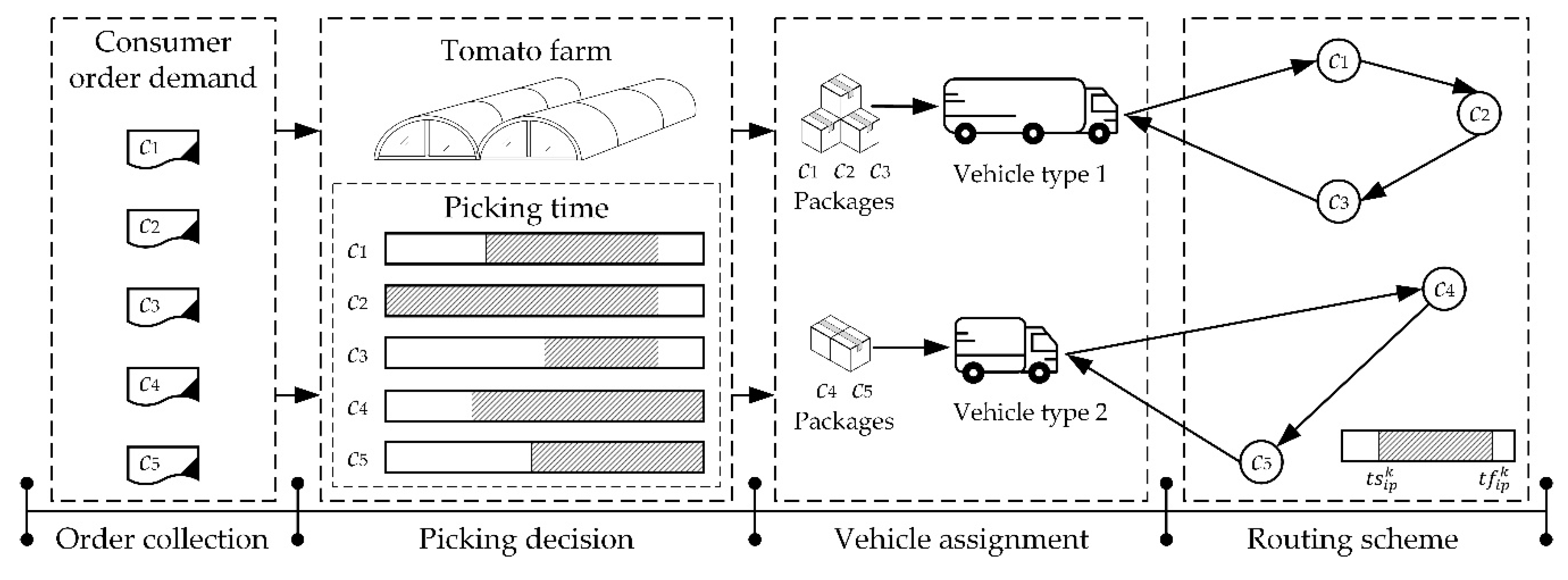


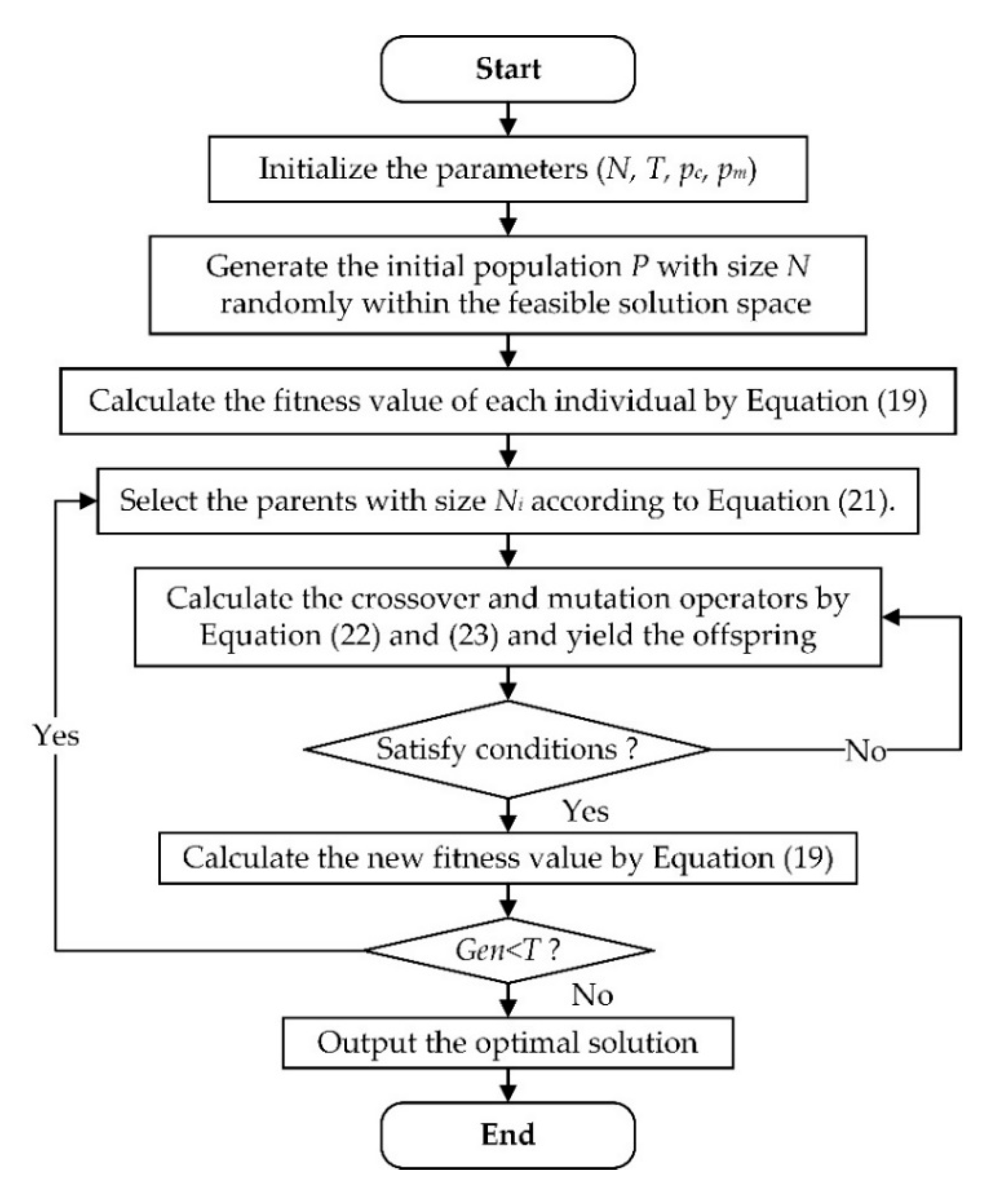



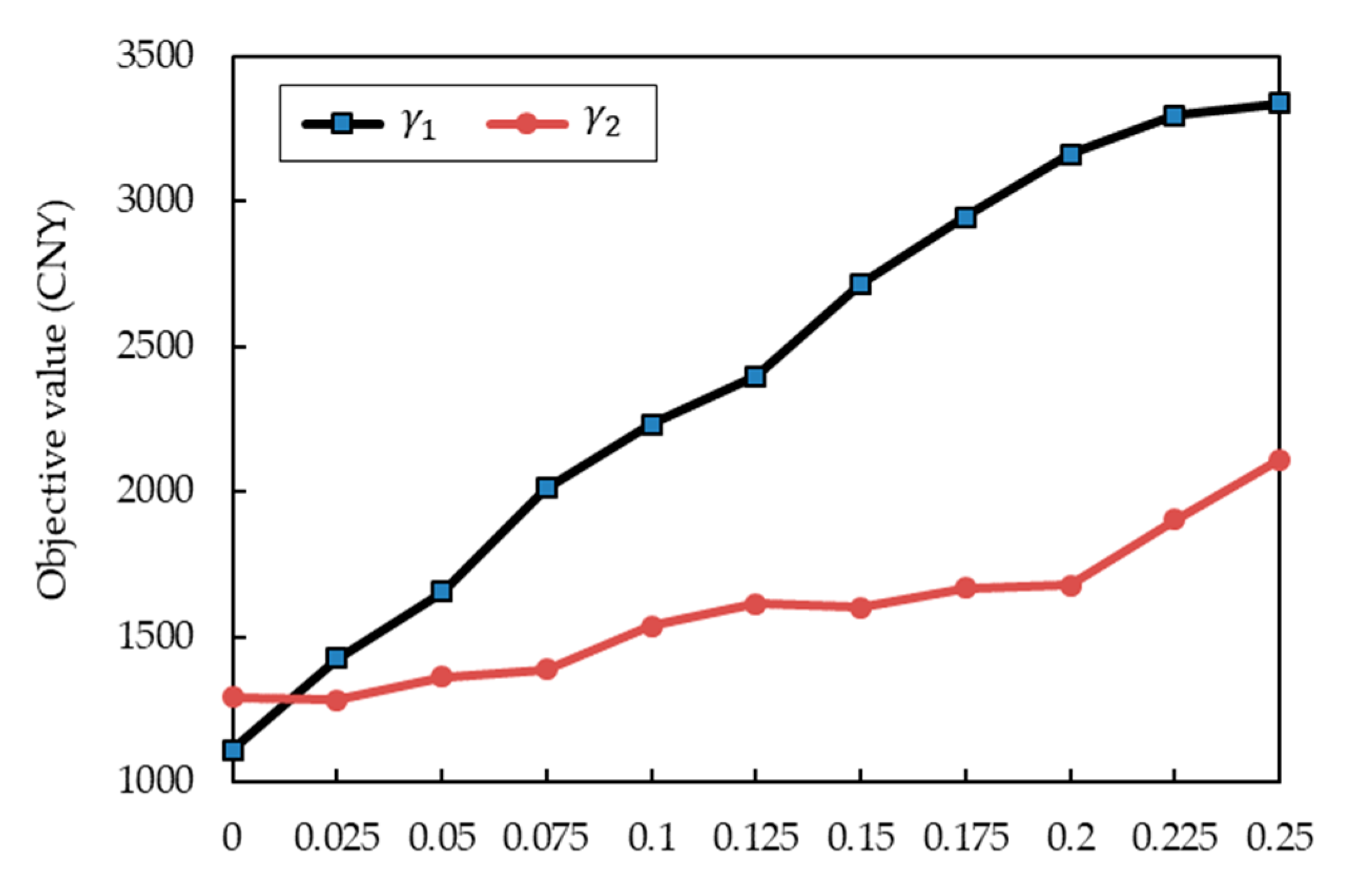
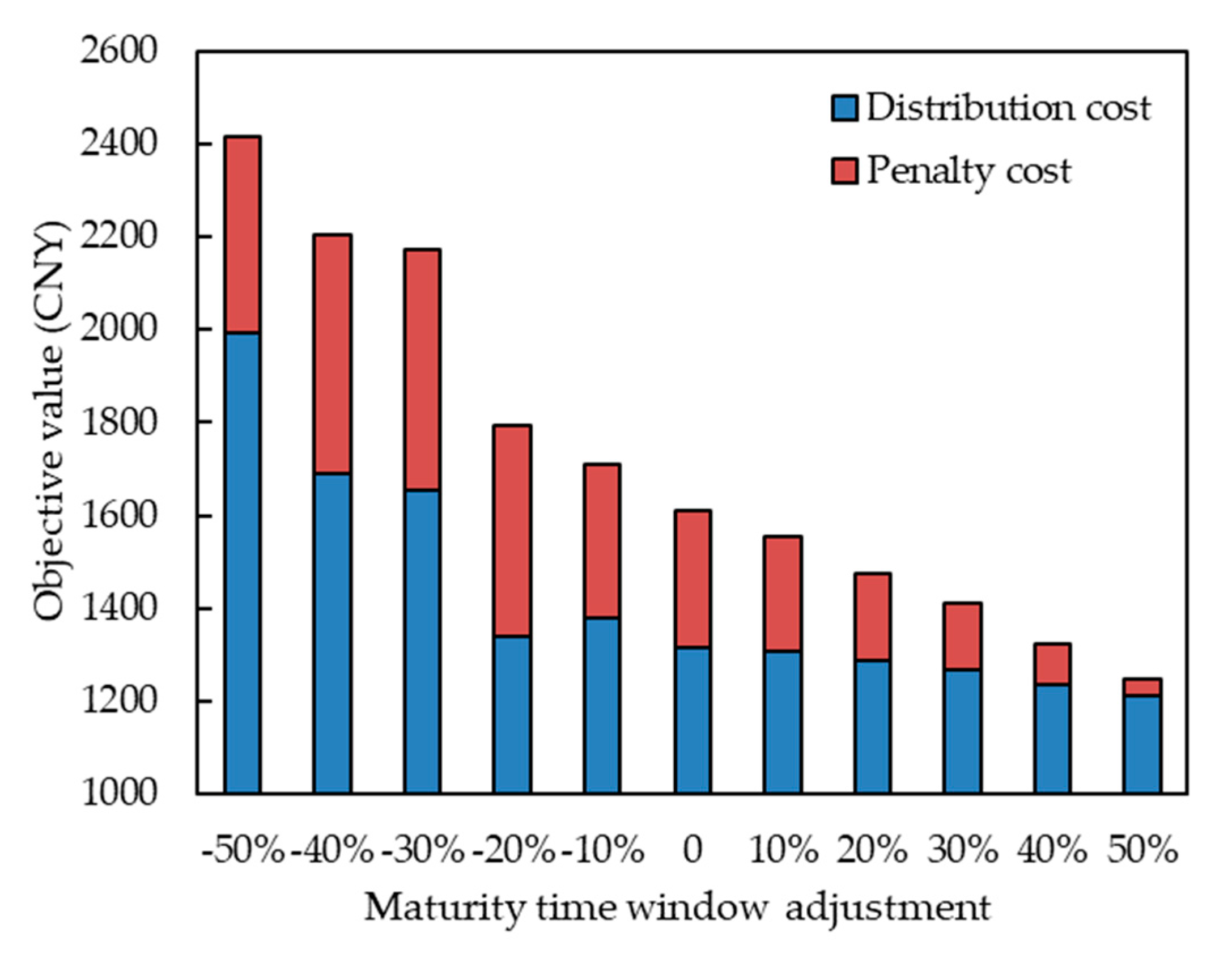
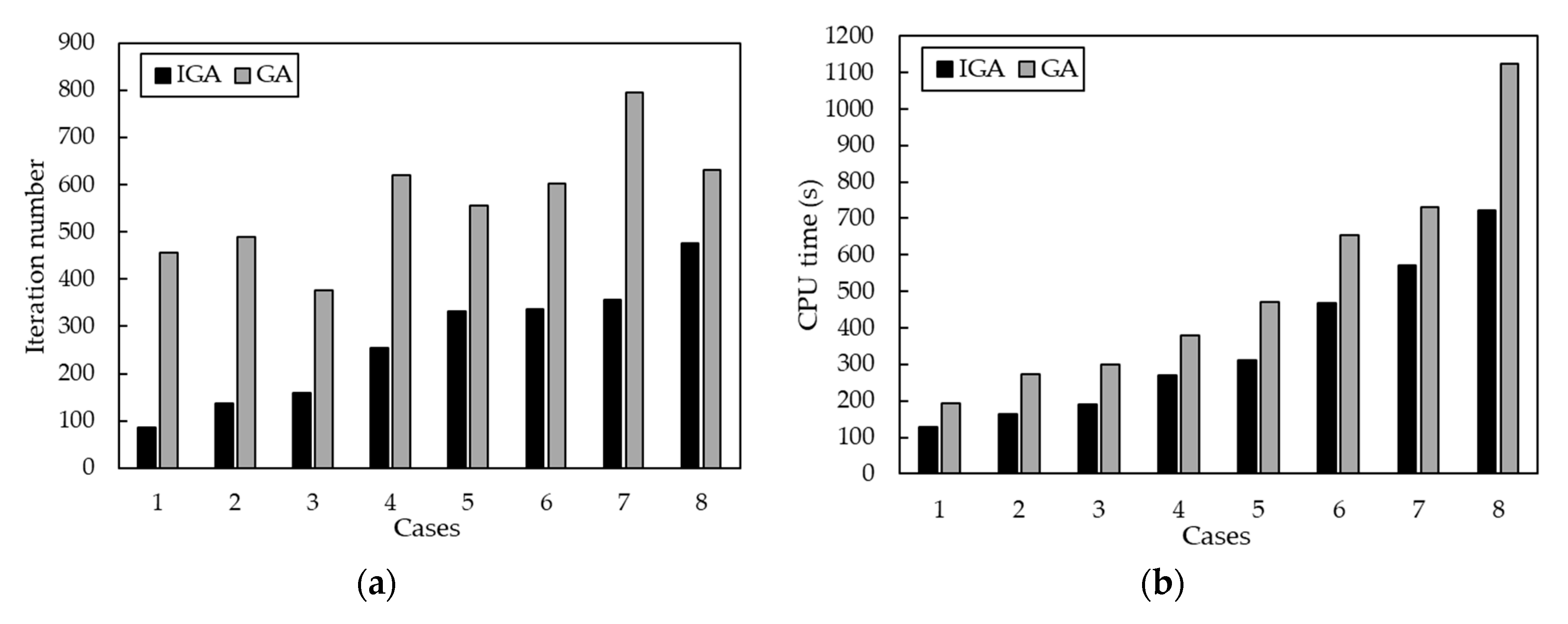
| Maturity Index | Maturity Stage | ||||
|---|---|---|---|---|---|
| Breaker | Turning | Pink | Light red | Red | |
| Firmness | 40.09 ± 1.69 A | 35.22 ± 1.93 B | 32.27 ± 2.04 C | 27.74 ± 1.30 D | 25.48 ± 1.81 E |
| SSC | 4.71 ± 0.20 E | 5.14 ± 0.15 D | 5.34 ± 0.15 C | 5.70 ± 0.19 B | 6.09 ± 0.22 A |
| Maturity Model | Equation | ||
|---|---|---|---|
| Firmness | Quadratic | 0.927 | 0.001 |
| SSC | Exponential | 0.856 | 0.011 |
| Maturity Stage | Firmness Value Range | Time Window |
|---|---|---|
| Breaker | 37.9–42.3 | 0–44 |
| Turning | 33.1–37.9 | 44–65 |
| Pink | 28.5–33.1 | 65–80 |
| Light red | 25.9–28.5 | 80–88 |
| Red | 22.1–25.9 | 88–98 |
| Number | Coordinate | Demand | Expected Maturity a | Number | Coordinate | Demand | Expected Maturity a |
|---|---|---|---|---|---|---|---|
| 0 | 0 | 0 | 11 | 12 | 2 | ||
| 1 | 10 | 4 | 12 | 19 | 5 | ||
| 2 | 7 | 4 | 13 | 23 | 3 | ||
| 3 | 13 | 4 | 14 | 20 | 3 | ||
| 4 | 19 | 5 | 15 | 27 | 4 | ||
| 5 | 26 | 1 | 16 | 19 | 4 | ||
| 6 | 21 | 2 | 17 | 14 | 5 | ||
| 7 | 17 | 2 | 18 | 12 | 5 | ||
| 8 | 9 | 3 | 19 | 17 | 2 | ||
| 9 | 16 | 4 | 20 | 31 | 3 | ||
| 10 | 16 | 2 |
| Vehicle Type | Vehicle Number | The Optimal Vehicle Routing | ||
| Type 1 | Vehicle 1 | 0→1→9→20→3→12→0 | ||
| Vehicle 2 | 0→7→10→11→19→8→17→18→0 | |||
| Vehicle 3 | 0→6→13→2→15→4→0 | |||
| Type 2 | Vehicle 1 | 0→5→16→14→0 | ||
| Objective value | Total Cost | Number of Vehicles | ||
| 295.94 CNY | 1314.63 CNY | 1610.57 CNY | 4 | |
| Model | Objective Value | |||
|---|---|---|---|---|
| Number of Vehicles | Total Cost | |||
| Joint model | 4 | 295.94 CNY | 1314.63 CNY | 1610.57 CNY |
| Traditional model | 3 | 829.06 CNY | 1138.92 CNY | 1967.98 CNY |
© 2020 by the authors. Licensee MDPI, Basel, Switzerland. This article is an open access article distributed under the terms and conditions of the Creative Commons Attribution (CC BY) license (http://creativecommons.org/licenses/by/4.0/).
Share and Cite
Zhang, Z.; Bian, B.; Jiang, Y. A Joint Decision-Making Approach for Tomato Picking and Distribution Considering Postharvest Maturity. Agronomy 2020, 10, 1330. https://doi.org/10.3390/agronomy10091330
Zhang Z, Bian B, Jiang Y. A Joint Decision-Making Approach for Tomato Picking and Distribution Considering Postharvest Maturity. Agronomy. 2020; 10(9):1330. https://doi.org/10.3390/agronomy10091330
Chicago/Turabian StyleZhang, Zhaotong, Bei Bian, and Yiping Jiang. 2020. "A Joint Decision-Making Approach for Tomato Picking and Distribution Considering Postharvest Maturity" Agronomy 10, no. 9: 1330. https://doi.org/10.3390/agronomy10091330
APA StyleZhang, Z., Bian, B., & Jiang, Y. (2020). A Joint Decision-Making Approach for Tomato Picking and Distribution Considering Postharvest Maturity. Agronomy, 10(9), 1330. https://doi.org/10.3390/agronomy10091330






